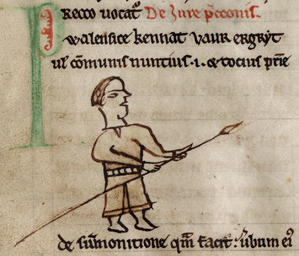
Create an Amazon Business Account
Illustration from a manuscript of
A Latin text of the Laws of Hywel Dda, mid 13th Century
National Library of Wales MS. Peniarth 28
The rhingyll, serjeant, holding the lance which pertained to his office. Detail of folio 6v. Y rhingyll, yn dal y wayw oedd yn perthyn i'w swydd.
You can support these web-sites by donating: |  or by making your Amazon purchases after clicking a link below: amazon amazon.co.uk amazon.es amazon.fr amazon.de |
Source: National Library of Wales Ms. Peniarth 28